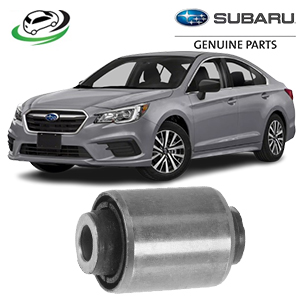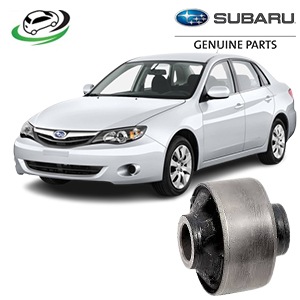-30%
Get Subaru Outback 2.5L 2006 Suspension Stabilizer Bar Bushing 20414AG070
The suspension stabilizer bar bushing is a crucial component of a vehicle’s suspension system that contributes significantly to ride quality, handling, and stability. This article will explore the functions, construction, benefits, signs of wear, maintenance, and replacement procedures of suspension stabilizer bar bushings, providing a thorough understanding of their significance in automotive performance.
1. What is a Suspension Stabilizer Bar Bushing?
The suspension stabilizer bar bushing is a rubber or polyurethane component that connects the stabilizer bar (also known as an anti-roll bar) to the vehicle’s frame or chassis. The stabilizer bar itself is designed to reduce body roll during cornering, enhancing vehicle stability and handling. The bushings allow the bar to pivot while dampening vibrations and noise, providing a more comfortable ride.
Structure and Composition
- Material: Stabilizer bar bushings are commonly made from rubber or polyurethane. Rubber bushings are effective in absorbing vibrations but may wear out more quickly. Polyurethane bushings are firmer, offering improved durability and performance, although they may transmit more road noise.
- Shape: The bushing typically consists of an inner metal sleeve surrounded by a layer of rubber or polyurethane. The metal sleeve provides structural integrity, while the outer layer absorbs shocks and vibrations.
2. Functions of Suspension Stabilizer Bar Bushings
The primary functions of suspension stabilizer bar bushings are essential for ensuring optimal vehicle performance and safety.
a. Allowing Pivoting Motion
Stabilizer bar bushings provide a pivot point for the stabilizer bar, allowing it to flex and move as needed. This flexibility is crucial for the stabilizer bar to perform its job effectively, helping to control body roll during cornering.
b. Absorbing Vibrations and Noise
Bushings act as a cushion between the stabilizer bar and the vehicle’s chassis, absorbing vibrations and noise. This dampening effect contributes to a smoother ride by minimizing harshness and sound transmission to the cabin.
c. Enhancing Stability and Handling
By reducing body roll and maintaining wheel contact with the road, stabilizer bar bushings play a significant role in improving handling and stability. This allows for better traction and control during turns, enhancing overall driving dynamics.
d. Supporting Load Distribution
The bushings help distribute loads and stresses within the suspension system. They absorb lateral forces during cornering, preventing excessive wear on the stabilizer bar and other suspension components.
3. Benefits of Properly Functioning Suspension Stabilizer Bar Bushings
When suspension stabilizer bar bushings are in good condition, they provide numerous benefits that enhance vehicle performance and driver comfort.
a. Improved Ride Quality
Well-functioning stabilizer bar bushings contribute to a smoother and more comfortable ride. By effectively absorbing bumps and vibrations, they help create a pleasant driving experience for both the driver and passengers.
b. Enhanced Handling and Cornering Performance
With properly functioning bushings, the stabilizer bar can effectively reduce body roll, improving handling and cornering capabilities. This leads to more precise steering response and overall better vehicle dynamics.
c. Reduced Tire Wear
Functional stabilizer bar bushings help maintain proper alignment and suspension geometry. This reduces uneven tire wear, extending the life of the tires and improving traction.
d. Increased Safety
The stabilizer bar is crucial for maintaining stability during cornering. Functional bushings ensure that the stabilizer bar operates as intended, reducing the risk of loss of control and enhancing overall safety on the road.
e. Cost-Effective Maintenance
Properly maintained stabilizer bar bushings can help prevent premature wear of other suspension components, saving money on repairs and replacements. Regular inspections and timely replacements can prevent more significant issues down the line.
4. Signs of Worn Suspension Stabilizer Bar Bushings
Over time, stabilizer bar bushings can wear out due to exposure to road conditions, environmental factors, and normal wear and tear. Recognizing the signs of worn bushings is crucial for maintaining vehicle safety and performance.
a. Clunking or Rattling Noises
One of the most common indicators of worn stabilizer bar bushings is clunking or rattling noises coming from the suspension. These sounds often occur when driving over bumps or uneven surfaces, indicating that the stabilizer bar is not functioning correctly.
b. Poor Handling and Increased Body Roll
If you notice that your vehicle feels less stable during cornering or exhibits excessive body roll, it may be a sign of worn stabilizer bar bushings. This can lead to a decrease in overall handling performance.
c. Vibration in the Steering Wheel
Excessive vibrations in the steering wheel, especially when cornering or driving over uneven surfaces, may suggest that the stabilizer bar bushings are worn. This can affect driving comfort and control.
d. Uneven Tire Wear
Worn stabilizer bar bushings can lead to misalignment of the suspension system, resulting in uneven tire wear. If you notice that your tires are wearing more on one side than the other, it may be time to inspect the bushings.
e. Increased Road Noise
If you notice an increase in road noise or harshness while driving, it could be a sign that the stabilizer bar bushings are worn and no longer effectively dampening vibrations.
5. Maintenance of Suspension Stabilizer Bar Bushings
Regular maintenance and timely replacement of suspension stabilizer bar bushings are essential for ensuring optimal vehicle performance and safety. Here are several key tips for maintaining these components:
a. Routine Inspections
Include stabilizer bar bushings in your regular vehicle inspections. Check for signs of wear, such as cracks, tears, or excessive movement. If any issues are detected, replacement is necessary.
b. Monitor for Unusual Noises and Handling
Stay alert for any unusual noises or changes in handling. If you hear clunking or experience increased body roll, have the bushings inspected immediately.
c. Keep the Suspension Clean
Dirt and debris can accelerate the wear of stabilizer bar bushings. Regularly clean the suspension components to prevent contamination and extend the life of the bushings.
d. Replace Worn Bushings Promptly
If you notice signs of wear or damage, replace the stabilizer bar bushings as soon as possible. Driving with worn bushings can lead to further damage to the suspension system and compromise vehicle safety.
e. Follow Manufacturer Recommendations
Consult the vehicle’s service manual for specific maintenance schedules and recommendations regarding stabilizer bar bushings. Adhering to these guidelines will help ensure optimal performance.
6. Steps to Replace Suspension Stabilizer Bar Bushings
Replacing suspension stabilizer bar bushings is a task that can typically be accomplished with basic tools and mechanical knowledge. Here’s a general guide on how to replace them:
1. Gather Necessary Tools
You’ll need basic tools such as a socket set, wrench, jack, jack stands, and a bushing press or hammer. Some vehicles may require specific tools, so consult your service manual.
2. Raise the Vehicle
Use a jack to lift the vehicle and secure it on jack stands. This will provide access to the suspension components.
3. Remove the Wheel
Take off the wheel on the side where you are replacing the stabilizer bar bushings to access the suspension.
4. Locate the Stabilizer Bar
Identify the stabilizer bar connected to the control arms and the vehicle’s chassis. The bushings are typically located at both ends of the stabilizer bar.
5. Remove the Stabilizer Bar
Unbolt the stabilizer bar from the control arms and the chassis. Depending on the vehicle, this may require removing other components for access.
6. Remove the Old Bushings
Using a bushing press or hammer, remove the old bushings from the stabilizer bar. Take care not to damage the stabilizer bar itself during this process.
7. Install New Bushings
Press the new bushings onto the stabilizer bar, ensuring they are properly aligned. Follow the manufacturer’s specifications for installation.
8. Reattach the Stabilizer Bar
Reattach the stabilizer bar to the control arms and the chassis, securing it with the appropriate bolts. Ensure that all fasteners are tightened to the manufacturer’s specifications.
9. Reinstall the Wheel
Put the wheel back on and tighten the lug nuts to the specified torque.
10. Lower the Vehicle
Carefully lower the vehicle back to the ground.
11. Test Drive the Vehicle
After replacing the stabilizer bar bushings, take the vehicle for a test drive to ensure that handling is smooth and responsive. Monitor for any unusual noises or handling characteristics.
Conclusion
Suspension stabilizer bar bushings are vital components of a vehicle’s suspension system, ensuring optimal performance, ride comfort, and safety. By allowing controlled pivoting motion, absorbing vibrations, and enhancing stability, they play a crucial role in vehicle dynamics. Regular inspection, maintenance, and timely replacement of worn stabilizer bar bushings are essential for optimizing vehicle performance and ensuring driver safety. Recognizing the signs of wear and addressing issues promptly will help extend the life of the suspension components and improve overall vehicle functionality.
Follow us on Facebook for more parts.






Reviews
Clear filtersThere are no reviews yet.